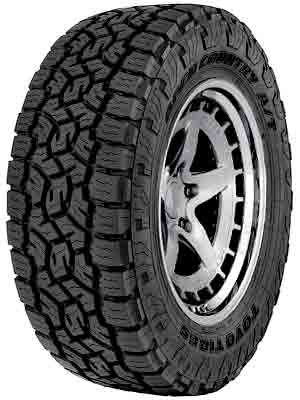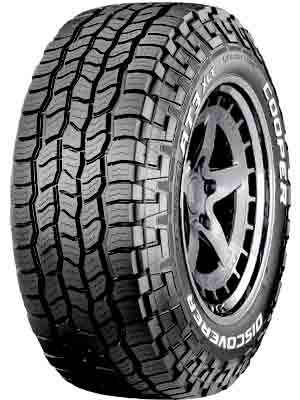In the vast universe of tire options, our focus is on Cooper Discoverer AT3 and the Toyo Open Country AT3, the two prominent All-Terrain (A/T) tires. Each of them features very unique tread structures, which accommodate the most demanding driving scenarios across diverse terrains.
But how do they truly stack up against each other? Let’s embark on a detailed exploration to find that out, and see which one is a better fit for you!

Basically it all comes down to this. I added the tabular form of what we are bout to discuss, so you can easily understand what’s going on with both of these tires.
| Features | Hankook Dynapro | Cooper Discoverer AT3 |
|---|---|---|
| Tread Design | Efficiently built, narrow spacing | More prominent, wider groove pattern |
| On-Road Traction | Excellent | Excellent |
| Off-Road Traction | Limited | Limited |
| Dry Performance | Good | Very Good |
| Wet Performance | Good | Excellent |
| Noise Levels | Average | Low |
| Comfort | Average | High |
| Durability | Average | Average |
| Fuel Efficiency | Good | Good |
Table of Contents
Tread Pattern
Starting with Toyo Open Country AT3, the tire comes with comparatively more random blocks, so they don’t offer a multi-directional grip. This offer great on-road (dry) traction.

It features S and F-shaped block, with deep notches and reinforced foundations, promoting stability.
As you can see they from off-set edges and notches facing in all directions, rendering grip from all sides.
Though all these lugs can really use some extra siping, as they re not enough. Though they are full depth and have interlocking pattern (which is better for wet grip).
Moving towards the shoulders, the tire comes with staggered edges, forming mud scoops.
All these shoulder blocks have foundational supports underneath.
And their lateral voids also have connectors in between, so you get very enhance stability on all types of surfaces.
Though the tire has very thin sidewall lugs, which are not so great when it comes to off-road traction.
So compared to its counterpart, they don’t offer as much grip with lowered air pressure.
Moving towards the Cooper AT3, you see a more pronounced tread design with wide-enough groove patterns, but they are longitudinally arranged.

In the middle the tire carries 3 main ribs of lugs running in pairs.
These lugs have reinforced foundations underneath, and they all carry wave-like sipes (much greater in number comparatively).
All of these ribs form zigzag vertical channels, where the outer two (against the shoulder lugs), are wider.
Speaking of which, the shoulder blocks are the biggest, though they carry similar features like snow vices and wave-like siping.
And yes, like you can see in the image, their outer edges are staggered, so you get thick mud scoops over there.
Furthermore, they also join up with the V shaped sidewall lugs of thicker proportions.
Dry On Road Traction:
When assessing on-road performance, it is essential to consider two critical factors: directional grip and cornering stability.
And both tires are great here.
The Cooper AT3 takes the lead in directional grip, which gets calculated with braking distances. This is because the tire features longitudinally aligned lugs, allowing for faster braking efficacy.
On the other side, the Toyo AT3 with its stiffer rubber composition, allows for superior handing capabilities, with its quicker responsiveness.
As mentioned in the tread section, its shoulder lugs (where most handling depends on), are very packed up and have ridges in between. So they stay in place, allowing for superior under and oversteering balance.
Cooper Discoverer AT3 on the other side with softer rubber composition can’t offer similar results, as it’s lugs flex more, wasting time to handle.
Wet Traction:
When it comes to wet performance, grip, handling, and hydroplaning resistance are the trifecta that define a tire’s performance (mostly).
And so let’s consider all of them to see why the Cooper Discoverer AT3 takes the lead here overall.
So first, the tire features good enough channels to allow majority of water to pass through, as the tire meets the watery surface.
This allows for decent hydroplaning resistance, almost similar to that seen on Toyo AT3. (Float speeds basically measure it).
Though the left over water is what causes most of the problems, and that’s where it gets tricky, as that has to be cleared off with the help of sipes, and Toyo Open Country AT3 doesn’t provide with many.
Whereas the Cooper AT3 with sipes, which remind you of dedicated winter tires, offer much superior gripping efficacy.
Moreover, the tires softer compound also help here, as they provide sipes the needed flexibility to create suction for water particles coming underneath.
Winter Traction
It’s really amazing to see Toyo Open Country AT3 with 3 peak mountain snowflake rating just like its counterpart, even though the tire has very little siping on its tread.
So how come?
Well because of the tire’s snow holding abilities. Its tread with notches everywhere basically grab and lodge the snow particles to generate snow to snow contact.
Its significant because snow stick better on each other, rather then rubber.
But still its performance can’t outperform the traction you get with Cooper Discover AT3, as this tire features a ton of siping everywhere.
All its sipes together with snow vices (on outer circumferential channels) supply greater snow to snow contact, relatively. And so superior winter traction is achieved.
Ride Quality
All-terrain tires are designed to deliver an optimum blend of performance and comfort. And that’s their main job.
So they must be comfortable. Otherwise, why not just get a mud-terrain tire instead and get superior off-road traction, right?
But no need for that, as both of our tires in discussion here are pretty comfortable. They are both coming in top quietest all terrain tires, and they both give you decent impact comfort performance as well.
First off, lets discuss noise.
Tread Noise
So noise is nothing more than air hitting the walls, and that air comes in form shoulders.
Now both tires incorporates what Cooper calls whisper grooves. These are basically rubber ridges placed between the shoulders, so that air could be restricted to flow inwards.
This way, noise is cut off at the source.
Additionally, both tires incorporate variable pitch technology. This means the lugs in the center display subtle variations in their geometry, which allows for the generation of different pitches and tones when they interact with air particles.
Consequently, the sound waves produced neutralize each other, preventing any potential amplification. This system serves to minimize noise, enhancing your driving experience.
On Road Vibrations
Addressing on-road vibrations is critical in ensuring overall ride quality.
In this regard, the Cooper AT3, with its softer rubber compound and flexible, single, spirally-wound inner nylon cap ply, delivers an excellent response to road imperfections. The result is a smoother and more comfortable ride, relatively.
In contrast, the Toyo Open Country AT3, with its stiffer rubber compound, tends to yield a more jittery ride experience.
Though it’s worth noting, that its handling and steering response are still commendable and they also contribute, to some degree, to the overall feel of the ride.
However, when considering the complete driving experience, the Cooper AT3 emerges as the clear winner. Its superior handling of road imperfections, ensures a more comfortable and smoother ride, no doubt.
Off Road Performance:
When venturing off-road, one must consider a variety of challenging terrains that can put a tire’s durability and performance to the test.
Let’s see how our tires here handle these circumstances.
Rocky Terrains
When navigating rocky terrains, two things are pretty vital. One, tire’s durability, and two, multi-directional grip.
And unfortunately, both the Cooper AT3 and Toyo Open Country AT3 fall short in these areas, as they’re not specifically designed to withstand harsh rocky conditions.
With only two-ply sidewalls and no polyamide or nylon reinforcement, these tires are vulnerable to punctures, relatively speaking (comparing with other tires).
However, when it comes to grip, they both perform decently.
The Cooper AT3 offers commendable lateral traction and climbing abilities due to its thicker sidewall lugs.
While the Toyo AT3, despite its lack of robust sidewall biters, provides nearly equivalent performance values, due to its F and S shaped blocks providing grip from multiple angles.
Mud Traction
Both of our tires here, aren’t suited for muddy conditions, mainly due to their susceptibility to accumulate thick, wet debris in their narrower channels. In other words, their less voided structure can’t escape out the thick clay in time.
For effective navigation of muddy terrains, tires need efficient self-cleaning capabilities to prevent mud-clogged treads, which can drastically reduce traction.
However, if one were to choose between the two, the Toyo Open Country AT3 would be the more reliable pick.
Its interconnected lug formation expels mud and debris in multiple directions, when it comes to lighter muddy tracks, that is.
On the other side, the Cooper AT3, with its longitudinal grooves, struggles to clear mud, especially sideways, resulting in a higher likelihood of mud accumulation, in comparison.
Sand Performance
On sandy terrains, lighter tires that can operate well, especially with lower air pressures and having large sidewall lugs.
All these features basically supply better floating abilities.
With this in mind, both the Cooper AT3 and the Toyo Open Country AT3 score equally, overall, after a lot of testing.
They feature lightweight structures, offer decent footprint capability, and possess sidewall lugs which spread over a large enough area.
These sidewalls expand to create a broader tread print, leading to superior traction.
Moreover, the traction scoops on both tires aid in paddling, scooping sand backward to generate forward momentum.
Fuel Usage
Fuel efficiency is closely connected to a tire’s rolling resistance, which is influenced by various factors, including tread design, composition, and depth, among others.
Now in terms of weight, both tires are almost similar (looking across all sizes). So it’s the rubber composition that tells why Toyo AT3 is better.
The tire features stiffer rubber, which don’t allow lugs to bend a lot as the tire turns, brakes or accelerates, for example.
So less energy is wasted there, and more is utilized in rolling of the tire.
And since the opposite happens in case of Cooper AT3, it makes sense why it consumes more fuel in comparison.
What’s the Verdict?
While the Toyo Open Country AT3 and the Cooper Discoverer AT3 are classified as all-terrain tires, they lean more towards on-road performance due to their tread designs and lightweight construction.
So they would not impress you off-road, but they are pretty great when it comes to dry and wet braking, handling and steering responsiveness.
Moreover, you also get great winter performance out of them, and it makes sense why they are branded with 3 peak mountain symbols.
And yes, they are both pretty comfortable both in terms of noise generation and impact comfort performance.